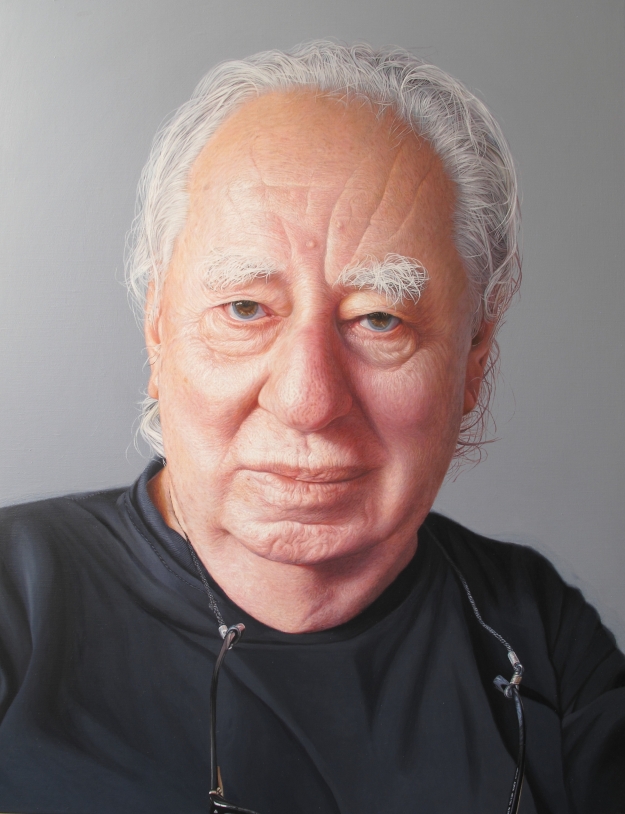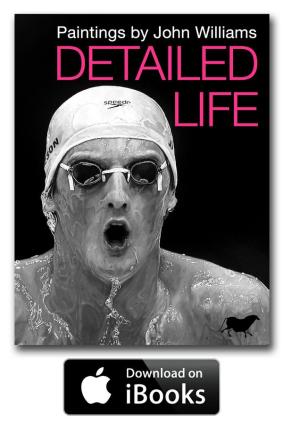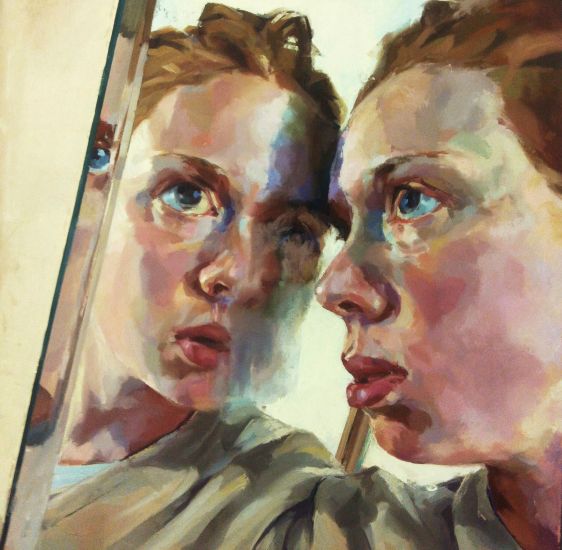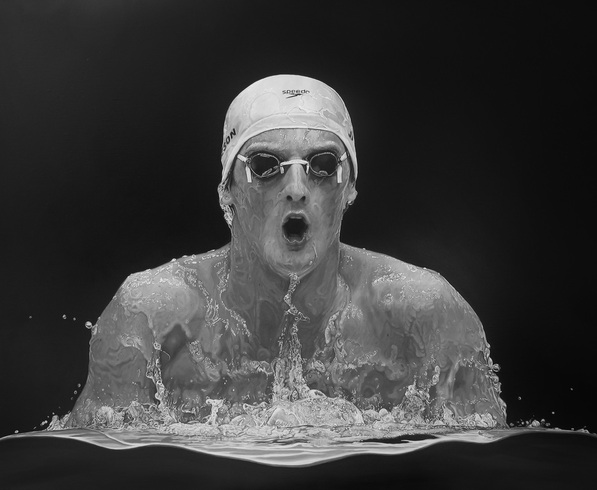Simon Wright is an artist living with his family in Norfolk. He teaches art full-time to secondary students, finding stolen moments in the evenings, over the weekend or during school holidays to create 15 to 25 paintings a year. He spoke to OPEN EXHIBITION about his work and his experiences entering art competitions over the past four years.
OE: Can you begin by describing your paintings.
SW: They’re rather small paintings, easel paintings. I consider myself to be a still life artist really, I work mainly from direct observations, but rather than traditional set ups, they’re objects that I’ve made.
OE: How much of an audience is there for your work where you are living, locally.
SW: I find that difficult to quantify. I have shown my work locally at galleries in Norwich and along the North Coast. But I don’t show many paintings, so I don’t really know what the audience is.
OE: I know for many artists working in less traditional, contemporary styles that London often feels like the only answer. Do you have that same feeling living where you are?
SW: I do. I can’t see a way for me to make enough money to be able to paint more…other than through representation from a London gallery, whereby I can sell work for higher sums of money.
OE: I think for many artists gallery representation is a primary goal. Of course, even for those galleries that take on new and emerging artists, they need to know, or at least be confident that your work will find an audience. Would you say open exhibitions have helped in that regard, if so how?
SW: (Entering exhibitions) seems like the only way to promote my work and get my work seen… in the sense that, I don’t produce a lot of work so I’m not approaching galleries saying, look I need a solo show. My stance has been I just want to get the paintings as good as I possibly can and, I suppose, gain some kind of recognition that would increase demand for the pictures.
Open exhibitions offer an opportunity for me to select work that I’ve done and then get them seen, potentially by people in London. So that’s been key for me in creating the beginnings of a CV.
OE: From your CV it looks as though you’ve been very successful, having work selected regularly to several major exhibitions a year since 2007. Has it really been an overnight success?
SW: I suppose since I’ve been trying to get the work out there and submit to open exhibitions it has been relatively quick. Although to me it seems like I’ve been working and trying to formulate my work for a long time, since my degree (1995). But things have started to come together in terms of producing work and showing work in the last 3 or 4 years.
OE: How many exhibitions do you enter or submit to each year?
SW: A lot more than actually works out. I tend to go for as much as I can, or I have done in the last couple of years. So there might be 10 that I might go for, that I like the look of, and that I think might be a good thing in terms of building awareness of my work or making connections.
OE: Do you only enter exhibitions in the London area?
SW: No, it’s not geographic, although it tends to be some what London-centric. I’m attracted to things where the people selecting the work are of interest to me. So the judges, if you like, or the panel that are going to be selecting work – if I’m interested in them, or if for example they’re artists that I respect or have an interest in, I would be or feel more encouraged to go for that sort of thing. Or if they’re galleries that if they see my work they might be interested. It’s a way to move my career forward.
OE: What was the first major open exhibition your work was selected for?
SW: I had a go at the Discerning Eye in 2006 and the work wasn’t accepted then, but I think it was the first show in 2007.
OE: In fact you had two paintings selected for the Discerning Eye, which has a unique selection process whereby 6 judges choose paintings from among the work entered. Blue Hut was chosen by Davina McCall and Corner was chosen by Jennifer McRae. Their method for selecting work sounds more personal; did you feel involved in any way in the process?
SW: No, no it’s all very distant; it’s just sort of taken care of… So far I haven’t made many connections from these things. In terms of personal connections with the selectors or even actually networking with other artists I don’t think I’ve really done that. It’s just been an opportunity to show my work amongst, in some cases desirable company, you know people you admire. It’s been also an opportunity to see work by other artists I’ve seen maybe on the internet and then I can go and see the work.
OE: One of your achievements has been having your work accepted to the Royal Academy’s Summer Exhibition, not once, but two years in a row. That’s quite an accomplishment when one considers over 10,000 pieces are submitted each year. Tell us about that.
SW: It was two works in 2008…Last year it was just one work, I think both got through the initial stages, but one hung. Which, I’m delighted about.
OE: And did the work exhibited sell?
SW: The Royal Academy, in my two year experience, seems to be a good place for selling work. Lots of the work in the small Weston Room sells fairly quickly… It’s been a lovely occasion, a bit of a lift, and the work has sold as well.
OE: I know in the summer of 2008 you also had paintings selected for the Cork Street Open Exhibition and, in fact, Interior was selected by the judges as the Grand Prize winner. And all four of the pieces you had in that exhibition sold as well.
SW: That was bordering on miraculous. It was very uplifting… brilliant. It was really lovely to be involved in that and to get that kind of recognition, and for the paintings to sell as well, that was really good.
OE: While the recognition is fantastic, lets look at this from a more practical or business point of view for just a minute. On average you’re submitting 2 pieces to 10 exhibitions, 20 pieces a year. You’ve spent money on materials and entry fees. You frame the work, transport it and collect it when it’s not chosen or doesn’t sell and if paintings do go through, hopefully, you go and see them once they’re hung. It doesn’t sound like a big money maker.
SW: It’s not a big money maker, or it hasn’t been for me so far. It’s been worthwhile financially, I’ve made more money than I’ve expended, so it has been worthwhile, but it hasn’t been enough… it hasn’t been enough to live off of. It’s not been enough yet, to allow me to do less of my day job and more of painting.
OE: So there must be intangibles then, benefits you’re looking for other than the bottom line.
SW: Absolutely, they’re to do with the CV, the career, building the beginnings of a CV, but for me they’re also kind of educational in that I’ll get to go and see other work and see my work amongst other work and that’s been a really useful learning experience… For me it’s been the only way to interact with whatever the art world is, and show work and connect with any kind of audience. It seems to me to be the most effective way to do that.
OE: I know that the pieces sold at the Cork Street Open Exhibition were bought by a dealer, not a gallery owner, but rather a dealer who participates in shows and sells the work on once he acquires it. So I know that your work is out there, that people are seeing it, and that, as it becomes more recognized over time, it will become more actively collected and, ultimately in higher demand.
SW: It’s not an overnight thing. I’ve spent a fair bit of time looking at artists that I like, that seem to be further along the path than me, and quite often you do see on their CVs in the early years open exhibitions. So I think this is just a way for artists to start, to go about showing work. I think it’s something that is effective in beginning a career so I would encourage people to use the opportunities, I think that the more the better in some ways.
Certainly you get rejections all the time and then you get accepted to things. There are highs and lows, but the main thing is, or the thing I realised recently is, whether I’m getting accepted or rejected there’s still a drive to get back in the studio and produce work and to keep it going, and that seems to be the important thing.
Discover more of Simon’s work here.



